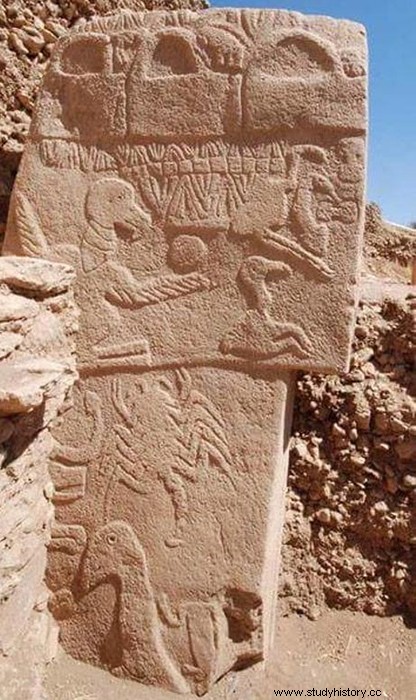
It is difficult to pinpoint the moment in which humans decided to say goodbye to their ancestors. According to Professor Juan Luis Arsuaga, the Homo Heidelbergesis that inhabited the Burgos prairies 400,000 years ago already had this ability to show their feelings in the face of the loss of a known being, in such a way that said human species might have already had the need to carry out a ritual to accompany the deceased in the final transit.
If with Homo Heidelbergis we fully enter the world of interpretations, in the last two human species that have coexisted in prehistory, that is, Neanderthals and Sapiens, this farewell ritual it is a proven fact. Note that the farewell rituals have been very varied, although we can point to two main ones; burial and cremation of bodies. Next to them one draws attention; let the vultures take care of the deceased for the elevation of him to heaven. This fact, which at first glance may seem like a return to the origins, contains deep beliefs among the different cultures that practiced it, and even practice it today.
The first representations.
To find the first signs of this practice we must go to Göbekli Tepe , considered the first sanctuary in history, and built by hunter-gatherers a few centuries before the first signs of sedentarization appeared. In this place and during one of the last excavation campaigns, the so-called "stone of the vulture" was found, in which a scene was found sculpted that reveals this type of ritual at least since the 10th millennium BC. C. We can observe how a vulture with a human head under its wing flies over a corpse, which is missing that part of the human body.

Göbekli Tepe Vulture Stone
It is not the only place where representations of this type have been found. About 700 km from the previous point, one of the oldest and most important Neolithic settlements in the Anatolian Peninsula was found. We are talking about Çatalhöyuk, dated between 6,500-5000 BC. C. Its great state of conservation has allowed us to find different mural paintings on its walls, including several scenes similar to the previous one, where several vultures flutter over headless human bodies. We are facing the verification of a common practice in a wide geographical and temporal space, during the prehistory of the Middle East.

Representation of the Çatalhöyuk scene
Zoroastrianism and vultures.
We are facing the religion that for thousands of years has contemplated this practice within its rituals. Zoroastrianism is considered one of the first monotheistic religions in history, practiced by the Iranian peoples and great civilizations such as the Persians from the 2nd millennium BC. C., contemplates a single creator god, Ahura Mazda. Among the ways of saying goodbye to their dead, until practically the 20th century, the delivery to the vultures is contemplated.

Maximum extension of the Persian Empire, its official religion Zoroastrianism.
Furthermore, thanks to this long space of time we know great details of the ancient ritual. Before death, the priests came home to give the orders to clean the dying person and the room itself where he was to die, all surrounded by the first prayers. After his death, he had to be disinfected and washed again, to later put on white clothes, and be able to spend the rest of the night accompanying him and reciting the different parts of the Avesta with the deceased.
The path to the Tower of Silence, which was located on the outskirts of the village, had to be done during the day, since the corpse had to be exposed to the purifying sun. In addition, it had to be transported on a metal surface, since wood, being a living matter, could transmit infections, and always by an even number of carriers, that is, two, four, or six, depending on the weight of the deceased. Of course all the bearers had to be dressed in white clothes that covered the whole body except for the eyes. Before arriving at the Tower, the less close friends and relatives had to say goodbye to the funeral procession, at the moment the body was undressed there was only the head of the family, the closest relatives and the priests. After the last prayers, the naked body was abandoned to be fed by the vultures that would raise the soul of the deceased to heaven. After the work of the vultures, sometimes really fast, only the skeleton remained that had to be crushed and turned into powder, then it was poured into a well attached to the Tower of Silence.

Tower of Silence in the vicinity of the current city of Yazd (Iran)
The practice in the pre-Roman peoples of the Iberian Peninsula.
This practice is also widely documented among the pre-Roman peoples of the Iberian Peninsula, specifically among those of Celtic origin, an unequivocal fact that reinforces the hypotheses about the Eastern origin of these peoples.

Recreation of the supposed farewell scene of a Celtiberian warrior.
Proof for the existence of the ritual of giving to the vultures appears in the classical sources. In the first place, we will attend to Silius Italicus, a Roman author of the 1st century AD. C. that describes the Second Punic War in seventeen volumes. Precisely in book III he describes this practice among the Celtiberian peoples, assigning it to the farewell of the most outstanding warriors of the community. Then we must add the vision of Claudius Eliano, a Greek living in Rome and a contemporary of Septimius Severus, who describes the same scene, adding the sacred character that these animals had for the Vacceos.
Archaeologically, the samples are numerous. In the first place, a subsection to signify that Blas de Taracena relied on this practice to explain the lack of a necropolis in the vicinity of Numancia. The discovery in 1993 of said necropolis notably minimized the perception that the throwing to the vultures was the main practice to fire Numantines, but the ceramic remains with vultures flying over corpses, give reason to the sources that point to a ritual of farewell to the bravest warriors in the community.
In addition to Numancia, remains have been found in other places on the Peninsula, such as, for example, in one of the largest pre-Roman sculptural groups, specifically that of Porcuna in Jaén, of all the rescued pieces include a vulture on a corpse, unfortunately this piece is one of the worst preserved of the large sample. Also in the steles of Lara de los Infantes (Burgos), or in the gigantic one of Zurita (Cantabria) there are samples of vultures flying over human corpses. Specifically, in the former, attempts have been made to assign them to a set of stelae where remains of a farewell ritual that included funerary banquets appear, although it is difficult to ensure the joint practice of both elements.

Detail of the Stele of Zurita (Cantabria)
Journey to the Tibetan interior.
To this day this practice continues, despite the ban, in some Indian villages, which are true strongholds of Zoroastrianism. But where it is most widely documented is inside the Tibetan Prefecture of Lhasa, specifically around the Buddhist monasteries of Drigung. There with the name of celestial burials , the monks continue to perform the daily rite of stripping the dead around hundreds of vultures, which finish off the bodies in a matter of minutes.

Drigung Tibetan Monastery
Tibetan Buddhists, in clear harmony with nature, continue to think that the best way to raise their deceased to heaven is by transporting these carrion birds. Today, despite the ban on taking and, above all, displaying images of this practice, they navigate through social networks from photographs to videos where this macabre practice is observed. This last adjective is obviously a personal assessment, from my eyes filtered by Western culture and religion. Due to both aspects, I allow myself not to share these scenes in Walking Through History.
More info:
ancient-origins
photographingtrip
avesta
beliefintheaftergrave
